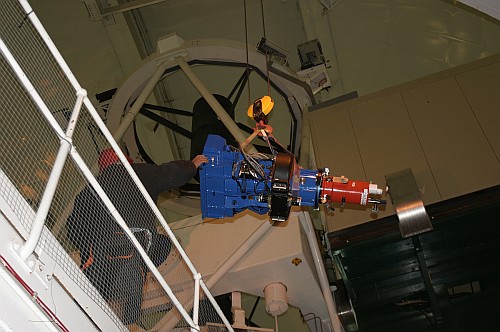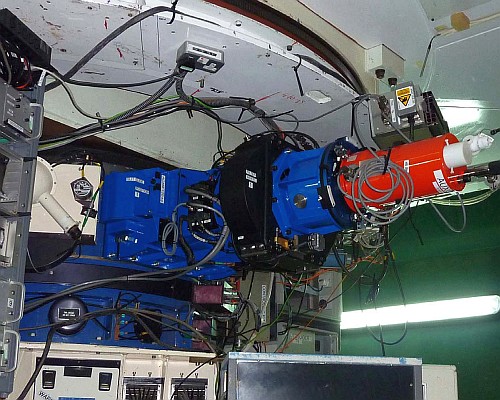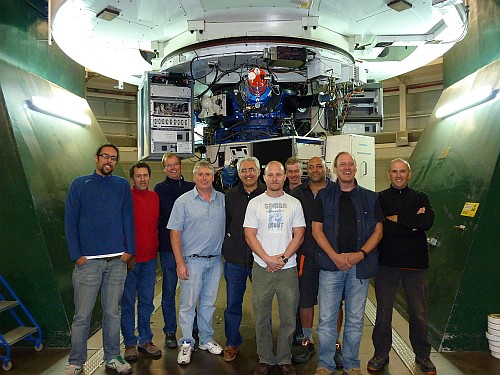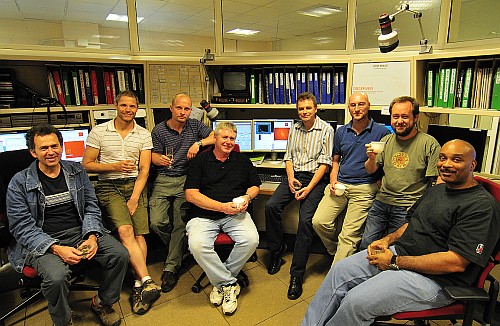First Light for ACAM - the WHT's New Imager / Spectrograph
ING web news release
16 July, 2009
A versatile new high-throughput imager and spectrograph, ACAM, was
successfully commissioned on the William Herschel Telescope
in June 2009, and is now available for use by the astronomical
community.
ACAM was designed entirely by engineers and astronomers at ING,
and was built in collaboration with
Kevin Dee of
Engineering & Project Solutions Ltd.
 |
ACAM first-light image of spiral galaxy Messier 51.
This is a composite of images through several different filters,
with red colour highlighting regions where new stars are forming.
The circular field of view is 8 arcmin across (about one quarter the
angular diameter of the moon).
Credit: Pablo Rodríguez-Gil, Chris Benn, Andrew Cardwell.
[ JPEG ].
|
ACAM can be used either for imaging (as above) through broad-band
or narrow-band filters, or for taking spectra.
In spectroscopy mode, the light from the object under study is
dispersed by a
VPH (volume-phase holographic) grating.
For a 0.5-arcsec slit,
the on-axis spectroscopic
resolution is approximately 900 at a wavelength of 6000Å.
ACAM is mounted permanently at a folded-Cassegrain focus
of the telescope, and can be deployed at a few minutes notice.
This allows astronomers to switch quickly from the main
camera in use for the night, to ACAM, for rapid follow-up of unusual
events.
ACAM's exceptional versatility will allow astronomers to carry out
a broad range of high-impact
science projects which otherwise would not be
possible with the WHT, in particular those requiring one or more
of:
rapid response;
narrow-band imaging;
wide field of view;
low-resolution spectroscopy;
or high camera throughput (very litte light is lost in the optics). Example projects include:
- Rapid follow-up of distant supernova explosions and gamma-ray bursts,
to investigate the physics of these violent events.
- Studies of large planets outside our solar system, e.g. time-series
imaging of the host stars to search for changes in orbital
periods hinting at the presence
of earth-sized planets.
- Narrow-band imaging of low-redshift galaxies, to
discover where in galaxies the formation of new stars takes place.
- Initial spectroscopic investigation of very faint objects
discovered serendipitously
with other WHT instruments.
 |
ACAM being craned up to the WHT.
Credit: Javier Méndez (ING). [ JPEG | TIFF ].
|
 |
ACAM, now mounted permanently at one of the folded Cassegrain foci
of the WHT.
Credit: Javier Méndez (ING). [ JPEG | TIFF ].
|
 |
Some of the ACAM team at the telescope:
Domingo Alvarez, Carlos Martin, Renee Pit, Kevin Dee,
Diego Cano, Tibor Agocs, Juerg Rey, Sevando Rodriguez,
Alan Chopping, Roberto Martinez.
Credit: Kevin Dee. [ JPEG ].
|
 |
The ACAM first-light team: Carlos Martín, Craige Bevil, Tibor Agocs,
Kevin Dee,
Chris Benn, Andrew Cardwell, Pablo Rodríguez and Don Abrams.
Credit: Pablo Rodríguez (ING). [ JPEG | TIFF ].
|
More information:
|
|



